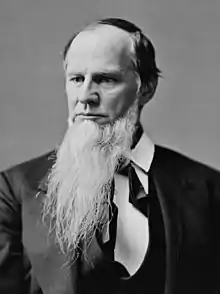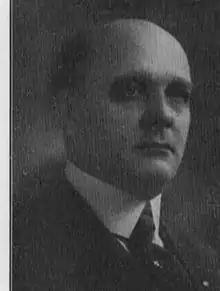United States District Court for the District of Vermont
The United States District Court for the District of Vermont (in case citations, D. Vt.) is the federal district court whose jurisdiction is the federal district of Vermont. The court has locations in Brattleboro, Burlington, and Rutland. The Court was created under the Judiciary Act of 1791 under the jurisdiction of the Eastern Circuit Court. Under the Midnight Judges Act, the Circuits were reorganised and this Court was assigned to the United States Court of Appeals for the Second Circuit where it has remained since. Originally created with one Judgeship, in 1966 a second Judgeship was added.
| United States District Court for the District of Vermont | |
|---|---|
| (D. Vt.) | |
 | |
 | |
| Location | Burlington |
| Appeals to | Second Circuit |
| Established | March 2, 1791 |
| Judges | 2 |
| Chief Judge | Geoffrey W. Crawford |
| Officers of the court | |
| U.S. Attorney | Christina E. Nolan |
| U.S. Marshal | Bradley Jay LaRose |
| www | |
Appeals from the District of Vermont are taken to the United States Court of Appeals for the Second Circuit (except for patent claims and claims against the U.S. government under the Tucker Act, which are appealed to the Federal Circuit).
The United States Attorney's Office for the District of Vermont represents the United States in civil and criminal litigation in the court. Christina E. Nolan has served as the United States Attorney for Vermont since 2017.
Current judges
As of December 21, 2017:
| # | Title | Judge | Duty station | Born | Term of service | Appointed by | ||
|---|---|---|---|---|---|---|---|---|
| Active | Chief | Senior | ||||||
| 20 | Chief Judge | Geoffrey W. Crawford | Rutland | 1954 | 2014–present | 2017–present | — | Obama |
| 19 | District Judge | Christina Reiss | Burlington | 1962 | 2009–present | 2010–2017 | — | Obama |
| 17 | Senior Judge | John Garvan Murtha | inactive | 1941 | 1995–2009 | 1995–2002 | 2009–present | Clinton |
| 18 | Senior Judge | William K. Sessions III | Burlington | 1947 | 1995–2014 | 2002–2010 | 2014–present | Clinton |
Former judges
| # | Judge | State | Born–died | Active service | Chief Judge | Senior status | Appointed by | Reason for termination |
|---|---|---|---|---|---|---|---|---|
| 1 | Nathaniel Chipman | VT | 1752–1843 | 1791–1793 | — | — | Washington | resignation |
| 2 | Samuel Hitchcock | VT | 1755–1813 | 1793–1801[Note 1] | — | — | Washington | elevation to 2d Cir. |
| 3 | Elijah Paine | VT | 1757–1842 | 1801–1842 | — | — | J. Adams | resignation |
| 4 | Samuel Prentiss | VT | 1782–1857 | 1842–1857 | — | — | Tyler | death |
| 5 | David Allen Smalley | VT | 1809–1877 | 1857–1877 | — | — | Pierce | death |
| 6 | Hoyt Henry Wheeler | VT | 1833–1906 | 1877–1906 | — | — | Hayes | retirement |
| 7 | James Loren Martin | VT | 1846–1915 | 1906–1915[Note 2] | — | — | T. Roosevelt | death |
| 8 | Harland Bradley Howe | VT | 1873–1946 | 1915–1940 | — | 1940–1945 | Wilson | retirement |
| 9 | James Patrick Leamy | VT | 1892–1949 | 1940–1949 | — | — | F. Roosevelt | death |
| 10 | Ernest W. Gibson Jr. | VT | 1901–1969 | 1949–1969 | 1966–1969 | — | Truman | death |
| 11 | Bernard Joseph Leddy | VT | 1910–1972 | 1966–1972 | 1969–1972 | — | L. Johnson | death |
| 12 | James L. Oakes | VT | 1924–2007 | 1970–1971 | — | — | Nixon | elevation to 2d Cir. |
| 13 | James Stuart Holden | VT | 1914–1996 | 1971–1984 | 1972–1983 | 1984–1996 | Nixon | death |
| 14 | Albert Wheeler Coffrin | VT | 1919–1993 | 1972–1989 | 1983–1988 | 1989–1993 | Nixon | death |
| 15 | Franklin S. Billings Jr. | VT | 1922–2014 | 1984–1994 | 1988–1991 | 1994–2014 | Reagan | death |
| 16 | Fred I. Parker | VT | 1938–2003 | 1990–1994 | 1991–1994 | — | G.H.W. Bush | elevation to 2d Cir. |
- Recess appointment; formally nominated on December 27, 1793, confirmed by the United States Senate on December 30, 1793, and received commission on January 28, 1794
- Recess appointment; formally nominated on December 3, 1906, confirmed by the Senate on December 11, 1906, and received commission the same day
Chief judges
Chief judges have administrative responsibilities with respect to their district court. Unlike the Supreme Court, where one justice is specifically nominated to be chief, the office of chief judge rotates among the district court judges. To be chief, a judge must have been in active service on the court for at least one year, be under the age of 65, and have not previously served as chief judge. A vacancy is filled by the judge highest in seniority among the group of qualified judges. The chief judge serves for a term of seven years or until age 70, whichever occurs first. The age restrictions are waived if no members of the court would otherwise be qualified for the position.
When the office was created in 1948, the chief judge was the longest-serving judge who had not elected to retire on what has since 1958 been known as senior status or declined to serve as chief judge. After August 6, 1959, judges could not become or remain chief after turning 70 years old. The current rules have been in operation since October 1, 1982.
Succession of seats
|
|
| ||||||||||||||||||||||||||||||||||||||||||||||||||||||||
U.S. Attorneys
U.S. Attorneys for Vermont since it attained statehood in 1791 include:[1][2]
U.S. Marshals and dates of appointment
Vermont's U.S. Marshals have included:[3][4]
- Lewis R. Morris, March 4, 1791
- Jabez G. Fitch, June 9, 1794
- John Willard, March 11, 1801
- David Robinson, January 7, 1811
- Heman Allen, December 14, 1818
- Joseph Edson, March 3, 1823
- Heman Lowry, June 6, 1829
- George W. Barker, December 30, 1835
- Heman Lowry, March 7, 1837
- William Barron, March 10, 1841
- Jacob Kent Jr., March 15, 1845
- John Pettes, March 13, 1849
- Charles Chapin, April 1, 1853
- Lewis S. Partridge, May 2, 1857
- Charles C. P. Baldwin, April 12, 1861
- Hugh H. Henry, July 25, 1865
- George P. Foster, January 24, 1870
- William W. Henry, April 10, 1879
- John Robinson, June 24, 1886
- Rollin Amsden, June 18, 1890
- Emory S. Harris, June 9, 1894
- Fred A. Field, June 14, 1898
- Frank H. Chapman, October 16, 1903
- Horace W. Bailey, October 21, 1903
- Arthur P. Carpenter, February 14, 1914
- Albert W. Harvey, June 2, 1922
- Edward L. Burke, June 7, 1935
- Dewey H. Perry, March 14, 1954
- Thomas W. Sorrell, August 3, 1961
- Christian Hansen Jr., June 20, 1969
- Earle B. McLaughlin, July 28, 1977
- Christian Hansen Jr., March 17, 1982
- John Edward Rouille, September 29, 1994
- John H. Sinclair, November 29, 1999
- John R. Edwards, March 18, 2002
- David E. Demag, August 18, 2009
- Bradley J. LaRose, January 2, 2019
See also
References
- Kestenbaum, Lawrence. "The Political Graveyard: U.S. District Attorneys in Vermont". politicalgraveyard.com.
- Davis, Mark (2017-06-07). "Will Vermont's Federal Prosecutors Get Tougher on Drug Crimes?". sevendaysvt.com.
- "District of Vermont History; List of Marshals". USmarshals.gov. United States Marshals Service. 2009. Retrieved January 3, 2019.
- "Senate confirms former Essex Police Chief Brad LaRose as Vermont's US Marshal". Vermont Business Magazine. South Burlington, VT. January 3, 2019.



.jpg.webp)

.jpg.webp)



.jpg.webp)



.jpg.webp)

.jpg.webp)

.jpg.webp)
.jpg.webp)

